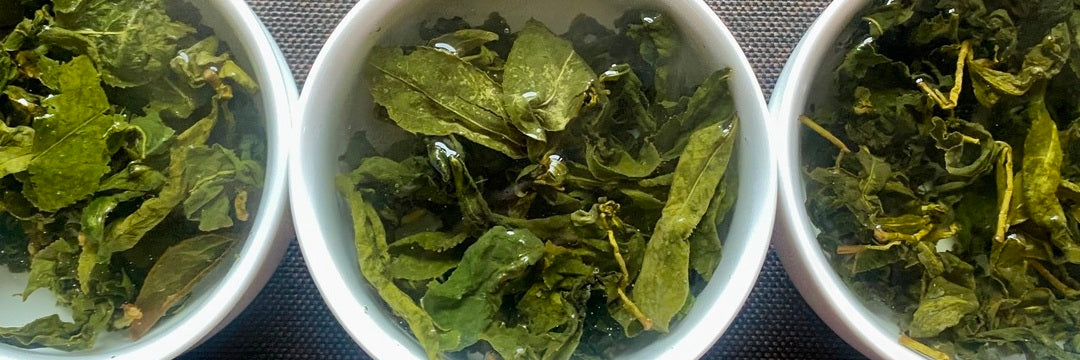
Taiwan High Mountain Oolong Tea Winter 2024

Shown above are our current winter 2024 batches Li Shan, Shan Lin Xi, and Alishan High Mountain Oolong Tea (left to right respectively). We used 8g of tea leaves in a standard 150mL tea judging cup brewed for 2 minutes, twice. This method offers a brew that is much closer how it tastes when brewed with a small tea pot gongfu style. This differs significantly from how tea is brewed in competition, where they only use 3g of tea and brew it for 6 minutes.
The first step in assessing the tea leaves is the visual appearance of the dried leaves, followed by the appearance of the brew tea.The differences are slight, but noticeable. The Li Shan leaf material is bulkier, mostly due to the thicker leaves and stems that represent the higher elevation at which they grow. Shan Lin Xi leaves are the most uniform in color and shape, exhibiting leaves that were picked while still young and supple. Alishan leaves are slightly larger, with a bit more oxidation evident in the coloration of leaves and stems. And the appearance of the dried leaves aligns with the brewed tea.

We also tasted these three winter teas the way it's most commonly done in tea factories by both tea craftsmen and merchants. It's the most expedient way to comprehensively compare different daily batches of tea from the same harvest. This is done by putting 6g of dried leaves directly into the tea bowl and filling it with boiling water.

In both of the cupping methods shown, the final and decisive activity involves ladeling the brewed teas with a spoon from the bowls into a cup, and tasting them in succession, again and again. When the leaves are brewed in the lidded cups, the tea is allowed to cool down significantly before tasting. The composition of the tea becomes less volatile as it cools, offering a more cohesive experience of the flavor profile. When the leaves are brewed directly in the bowls, it is tasted while the leaves brew. Tasting the tea when the leaves have brewed for about 3 minutes offers an initial impression. The leaves are still reconstituting, and the more subtle and volatile notes are prominent. The brewed tea becomes more concentrated moment to moment. So this "leaves in a bowl" method offers a streamlined experience of tasting the tea as it brews. More water can be added as you go. Some prefer to pour out the brewed tea from the bowls when it gets too strong, and brew a second time to see what the leaves offer on a second brew.

The Shan Lin Xi is the least oxidized among the three. It has a delicate and complex character that offers fresh green herbal notes with higher floral notes in the finish. This batch is most representative of a standard High Mountain Tea from Taiwan — especially how it was made in the early days when this tea type hit the market in the late 1980's and early 90's.
LET US KNOW!
Please post any questions or comments you may have in the comments section below!
SUBSCRIBE!
If you enjoyed this post and would like to hear more about the specialty tea industry here in Taiwan, follow us on YouTube, Facebook, and Instagram and please subscribe to our newsletter. Subscribe now and get US$5 off your first order.

